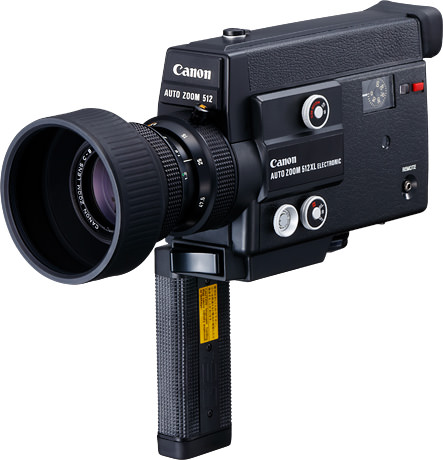8mm Movie Camera
Auto Zoom 512XL Electronic![]()
Auto Zoom 512XL Electronic![]()
Auto Zoom 512XL Electronic![]()
 Japan
Japan Americas
Americas Europe, Asia, Oceania
Europe, Asia, Oceania
- Outline
- Specifications
| Marketed | March, 1975 |
| Original Price | 72,000 yen |
Eastman Kodak Company announced its XL system in 1971. This system improved part of the camera mechanism to increase the volume of the light reaching the film surface. It also made it possible to shoot under dim light conditions with high-speed film. “XL” stood for “Existing Light.” Canon developed a new XL shutter mechanism with a 220-degree shutter opening and low noise, as well as a new 5x f/1.2 zoom lens, which was considered the highest performance lens, even at the full opening, for the XL system at that time.
Macro shooting as close as 5 cm from the lens top with the wide macro setting was also possible. The viewfinder became brighter and more precise. The exterior was changed from the traditional metallic image to black. A rubber foldable lens hood was attached at the lens top. From this model onward, all Canon 8mm movie cameras were XL type.
| Type | Super 8 type 8mm movie camera | |
| Image Size | 4.2 x 5.7 mm (Projection image size: 4 x 5.4mm) | |
| Film | Super 8 film cartridge | |
| Lens | Focal Length/Speed | 9.5 – 47.5mm f/1.2 (17 elements in 12 groups, including 11 new type glass elements). Spectra-coating. Built-in rubber hood. |
| Zooming Ratio | 5x | |
| Focusing | Manual (Front lens group rotating method), 1.2 m to infinity | |
| Macro Shooting | Close distance shooting by turning the zoom ring to “Macro” at the wide-angle end. Close-up shooting at 50 mm from the top end of the lens. Field of view: 38.6 x 53.1 mm | |
| Zooming | Power zooming (Approx. 6-10 sec.) and manual zooming with zooming ring. Rotation angle: Approx. 120 degrees. | |
| Filter Size | 48 mm | |
| Viewfinder | Type | Single-lens reflex type (built-in eyecup) |
| Rangefinder | Split-image rangefinder | |
| Dioptric Adjustment | -4 to +2 diopter | |
| Viewfinder Information | Aperture value, over/under exposure warnings | |
| Exposure Control | Type | TTL EE with a CdS exposure meter. Automatic aperture setting coupled to loaded film speed and filming speed. |
| Metering Range | ISO 250, f/1.2, 9 fps – ISO25, f/45, slow motion (36 fps) | |
| Film Speed | Automatic ISO setting by film cartridge Tungsten type film: ISO 25, 40, 64, 100, 160 and 250 Daylight type film: ISO 16, 25, 40, 64, 100 and 160 |
|
| CCA Filter | A Color Conversion filter A is built-in to use tungsten type film under daylight. The CCA filter is automatically cancelled with loading of a daylight type film cartridge. Manual cancellation of the CCA filter is possible. | |
| Manual Aperture Control | Manual aperture setting with the EE/Manual aperture control ring. Fade in/out possible with manual aperture control. | |
| Film Drive | Type | Power filming by a high performance micro-motor |
| Filming Speed | 9, 18 fps, slow motion (Approx. 36 fps) and single frame | |
| Power Source | Four AA batteries in the grip for film drive, power zooming and exposure metering. | |
| Battery Life | Sufficient power for 10 film cartridges under normal temperature (One cartridge for single frame shooting) | |
| Footage Counter | Counts up. Automatic resetting by unloading of a cartridge. | |
| Battery Check | Push button checking. | |
| Shutter | Shutter Opening | 220 degrees |
| Release Socket | Socket for remote control/single frame shooting | |
| Main Switch | Three way switch for off, run, running lock and single frame. Works as a safety lock also. | |
| Safety Device | Preventing mistakes on shooting: over/under exposure warning and film transportation confirmation window. | |
| Remote Control | Possible with the Remote Switch 60 or 3. | |
| Grip | Folding type. Contains batteries. | |
| Dimensions (W x H x D) | 79 x 118.5 x 255 mm | |
| Weight | 1,275 g (Body only), 1350 g (Including batteries) | |


